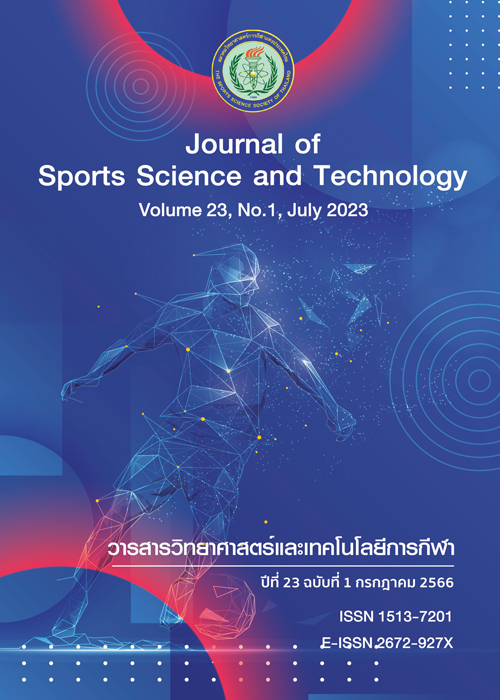WADA 2023 PROHIBITED LIST FOR ATHLETES
Current prohibited list for athletic
DOI:
https://doi.org/10.14456/jsst.2023.1Keywords:
WADA, athletes, prohibited substances, WADA - Accredited LaboratoryAbstract
Today, doping is an international issue that affects all sporting activities. The World Anti-Doping Agency (WADA) creates the so-called Prohibited List, which is updated at least once a year and contains all substances and methods that are prohibited in sports. It is the responsibility of athletes, coaches, and sports medicine professionals to be aware of which practices and substances are prohibited by the Prohibited List. The purpose of this article is to update the current prohibited substances and practices as well as substances that might be applied for the Therapeutic Use Exemption (TUE). The most advancement in current analytical techniques used by WADA-Accredited Laboratories to enhance the detection of doping agents in sports is also described.
(Journal of Sports Science and Technology 2023;23 (1): 8-17)
(Received: 20 November 2022, Revised: 7 March 2023, Accepted: 10 March 2023)
Key words: WADA/ Athletes/ Prohibited Substances/ WADA - Accredited Laboratory
*Corresponding author: Rungkan POOTRAKRONCHAI
National Doping Control Centre, Analytical Sciences and National Doping Test Institute,
Mahidol University, Rama 6 Road, Bangkok, Thailand.
Tel.+66-89-245 6359; e-mail: rungkan.poo@mahidol.ac.th
References
Wikipedia. World Anti-Doping Agency [Internet]. 2022 [cited 2022 June 07]. Available from: https://en.wikipedia.org/wiki/World_Anti-Doping_Agency.
The Ministry of Tourism and Sports. Government gazette 2022 Prohibited List 2022;138 (314):5.
Kosum C. Prohibited agents and doping control analysis. Huachiew Chalermprakiet Sci Technol J 2015;1(2):7-15.
Janeyuth C, Sethapong L. Effects of performance-enhancing drugs in athletes. J Sports Sci Technol [Intenet]. 2022 [cited 2022 October 20]; 22 (Online Edition 2). Available from: https://he01.tci-thaijo.org/index.php/JSST/article/view/257298/174598.
World anti-doping code international standard prohibited list 2023 [Internet]. 2022 [cited 2022 October 01]. Available from: https://www.wada-ama.org/sites/default/files/2022-09/2023list_en_final_9_september_2022.pdf.
Thiblin, I., & Petersson, A. Pharmacoepidemiology of anabolic androgenic steroids: a review. Fundam Clin Pharmacol. 2005;19(1): 27–44.
Prather ID, Brown DE, North P, Wilson JR. Clenbuterol: a substitute for anabolic steroids?. Med Sci Sports Exerc. 1995; 27(8):1118-1121.
Rahnema CD, Crosnoe LE, Kim ED. Designer steroids - over-the-counter supplements and their androgenic component: review of an increasing problem. Andrology. 2015; 3(2):150-155.
Van Thuyne W, Van Eenoo P, Delbeke FT. Nutritional supplements: prevalence of use and contamination with doping agents. Nutr Res Rev. 2006;19(1):147-158.
Kazlauskas R. Designer steroids. Handb Exp Pharmacol. 2010;(195):155-185.
Lootens L, Meuleman P, Leroux-Roels G, Van Eenoo P. Metabolic studies with promagnon, methylclostebol and methasterone in the uPA+/+-SCID chimeric mice. J Steroid Biochem Mol Biol. 2011;127(3-5):374-381.
Reichel C. Detection of peptidic erythropoiesis-stimulating agents in sport. Br J Sports Med. 2014;48(10):842–847.
Philip M, Karakka Kal AK, Subhahar MB, Karatt TK, Mathew B, Perwad Z. In vitro studies of hypoxia inducible factor-prolyl hydroxylase inhibitors daprodustat, desidustat, and vadadustat for equine doping control. Drug Test Anal. 2022;14(2):317-348.
Griffin JE., Wilson JD. Disorders of the testes and male reproductive tract. In: William Textbook of Endocrinology ,Wilson JD, Foster DW, editors. Saunders: Philadelphia; 1985, p. 259.
Guha N, Cowan DA, Sönksen PH, Holt RI. Insulin-like growth factor-I (IGF-I) misuse in athletes and potential methods for detection. Anal Bioanal Chem. 2013;405(30):9669-9683.
Heuberger JAAC, Cohen AF. Review of WADA Prohibited Substances: Limited Evidence for Performance-Enhancing Effects. Sports Med. 2019;49(4):525-539.
Filomena M, Domenico T. Hormone and metabolic modulators, combined pill and progestogen only pill in sport: study of their use. Acta Medica Mediterranea, 2020; 36: 443.
Birzniece V, Sutanto S, & Ho KK. Gender difference in the neuroendocrine regulation of growth hormone axis by selective estrogen receptor modulators. Journal of Clinical Endocrinology And Metabolism. 2012; 97(4): E521-E527.
Birzniece V, Sata A, Sutanto S & Ho KK. Neuroendocrine regulation of growth hormone and androgen axes by selective estrogen receptor modulators in healthy men. J Clin Endocrinol Metab. 2010; 95: 5443–5448.
Fedoruk MN, Rupert JL. Myostatin inhibition: a potential performance enhancement strategy?. Scand J Med Sci Sports. 2008;18(2):123-131.
Schobersberger W, Dünnwald T, Gmeiner G, Blank C. Story behind meldonium-from pharmacology to performance enhancement: a narrative review. Br J Sports Med. 2017;51(1):22-25.
What you need to know about meldonium, the banned substance used by Maria Sharapova. Men’s journal [Internet]. 2022 [cited 2022 October 01]. Available from: https://www.mensjournal.com/sports/what-you-need-know-about-meldonium-banned-substance-used-maria-sharapova/.
Russian curler Alexander Krushelnitsky banned 4 years in Olympic doping case. espn [Internet]. 2022 [cited 2022 October 01]. Available from: https://www.espn.com/olympics/story/_/id/25453076/russian-curler-alexander-krushelnitsky-banned-4-years-olympic-doping-case.
Wheelchair curler allowed to compete at Beijing 2022 despite failed drugs test banned for six months. Inside the games [Internet]. 2022 [cited 2022 October 01]. Available from: https://www.insidethegames.biz/articles/1128145/francoise-jaquerod-ban.
Avois L, Robinson N, Saudan C, Baume N, Mangin P, Saugy M. Central nervous system stimulants and sport practice. Br J Sports Med. 2006;40 Suppl 1:16-20.
Wada-ama.org [Internet]. WADA Executive Committee approves 2023 Prohibited List. [updated 2022 Sept 23; cited 2022 October 09]. Available from: https://www.wada-ama.org/en/news/wada-executive-committee-approves-2023-prohibited-list.
WADA Technical Document – TD2021DL. Decision limits for the confirmatory quantification of exogenous threshold substances by chromatography-based analytical methods. [Internet]. 2022 [cited 2022 October 01]. Available from: https://www.wada-ama.org/sites/default/files/2022-01/td2022dl_v1.0_final_eng_0.pdf.
Ventura R, Daley-Yates P, Mazzoni I, et al. A novel approach to improve detection of glucocorticoid doping in sport with new guidance for physicians prescribing for athletes [published online ahead of print, 2021 Apr 20]. Br J Sports Med. 2021;bjsports-2020-103512.
Rungkan P et al. Method Validation for d, l-Isomers of Methamphetamine and Amphetamine by GC/MS: In: Schänzer W, Geyer H, Gotzmann A, Mareck U, editors. Sport and BuchStrauß – Köln. Recent Advances In Doping Analysis (15); 2007: 355-8.






